Prosci has researched change management best practices for more than 20 years. For every edition of Best Practices in Change Management, we ask our study participants,
“What are the greatest contributors to a successful change management initiative?”
Collectively and consistently, participant responses point to seven straightforward factors that impact the results of a change initiative. These are the best practices of change management, as reported to Prosci by more than 8,000 individuals involved in change management.
7 Change Management Best Practices
-
- Mobilise active and visible executive sponsorship
- Apply a structured change management approach
- Communicate frequently and openly
- Engage with front-line employees
- Dedicate change management resources
- Engage and integrate with project management
- Engage with and support middle managers
Research participants who identified these contributors were experienced practitioners, project leaders, executives and consultants. Sixty-two percent of participants in the 11th edition of Best Practices in Change Management had more than four years of involvement in applying change management, and almost 25% had more than 12 years.
1. Mobilize Active and Visible Sponsorship
Having a positive leader who actively guides the organisation through change and participates visibly throughout the lifecycle of change is the greatest contributor to success. The importance of sponsorship was cited four times more frequently than the next contributor to change success. Participants consistently used the key words “active and visible” to describe this top contributor. Active and visible sponsorship means the sponsor is:
- Supporting the change by giving consistent attention to the change and the need for change management
- Championing the change by leading and motivating others in the organisation
- Making effective and influential decisions regarding the change, including aligning priorities among other leaders in the organisation
- Maintaining direct communication with the project management and change management teams, and remains accessible during the change
- Influencing peers to maintain buy-in and participate in a coalition of sponsorship
The graph below shows a clear correlation between the effectiveness of sponsorship and the likelihood of meeting project objectives. Projects with extremely effective sponsors were more than twice as likely to meet their objectives than those with very ineffective sponsors.
If you are not sure how to help your sponsor become active and visible, or if you are a sponsor and want more clarification, read this article on a sponsor’s role.
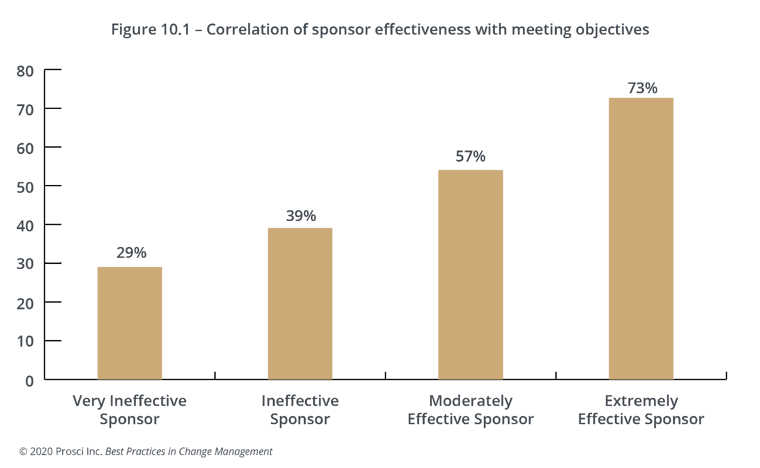
2. Apply a Structured Change Management Approach
An intentional and defined approach to managing change provides the structure necessary to stay on track. It earmarks adequate time for meaningful activities and allows space to identify and address gaps throughout the project lifecycle. Using a formal approach also makes processes repeatable for consistent application of change management on more initiatives throughout the organisation. Key words that emerged when participants described this best practice included:
- Established
- Customisable
- Scalable
- Easy to implement across multiple changes
- Easy to apply at every phase of the project
How organisations use a structured approach varied in the research. Seventy-six percent use a change management methodology for general guidance, while 46% use it as a checklist for activities and 38% use it to monitor progress (participants were able to select multiple responses, resulting in a total of more than 100%).
Again, the research reveals just how much applying a structured approach contributes to success. Participants who applied a structured approach were 33% more likely to experience good or excellent change management effectiveness than those without a methodology.

3. Communicate Frequently and Openly
Change management practitioners often struggle against the misconception that change management is “just communications.” Although change management is much more than that, effective communications are critical to leading change successfully. Beyond frequency, participants cited these factors as important to success:
- Cadence
- Consistency
- Transparency
- Leveraging multiple communications channels
- Preferred senders
Additionally, participants identified important topics to communicate such as why the change is happening, expectations, long-term plan perspectives, how the change will impact employees, and essential business drivers.
4. Engage With Front-Line Employees
We apply change management to help employees understand why change is necessary and how it will affect them, and to equip them to transition through the process successfully—which results in successful outcomes for organisations. Given this objective, it is clear why employee engagement and participation was identified as a top contributor to success. Tactics to increase engagement include:
- Highlighting “What’s in it for me?” (WIIFM)
- Identifying and building relationships with impacted groups
- Ensuring impacted groups receive the appropriate level of training
- Involving employees in identifying a proposed solution and future state
The goal of these efforts is to help employees demonstrate willingness to participate in the change and collaborate with the people leading the change.
Reinforcement is a critical step in the change management process. Because most organisations are saturated with change today, and practitioners must juggle many changes concurrently, they often neglect this step. Inadequately addressing reinforcement and sustainment activities has a negative impact on the overall outcome of the change. Participants who planned for reinforcement activities were 20% more likely to achieve project objectives than those who did not.
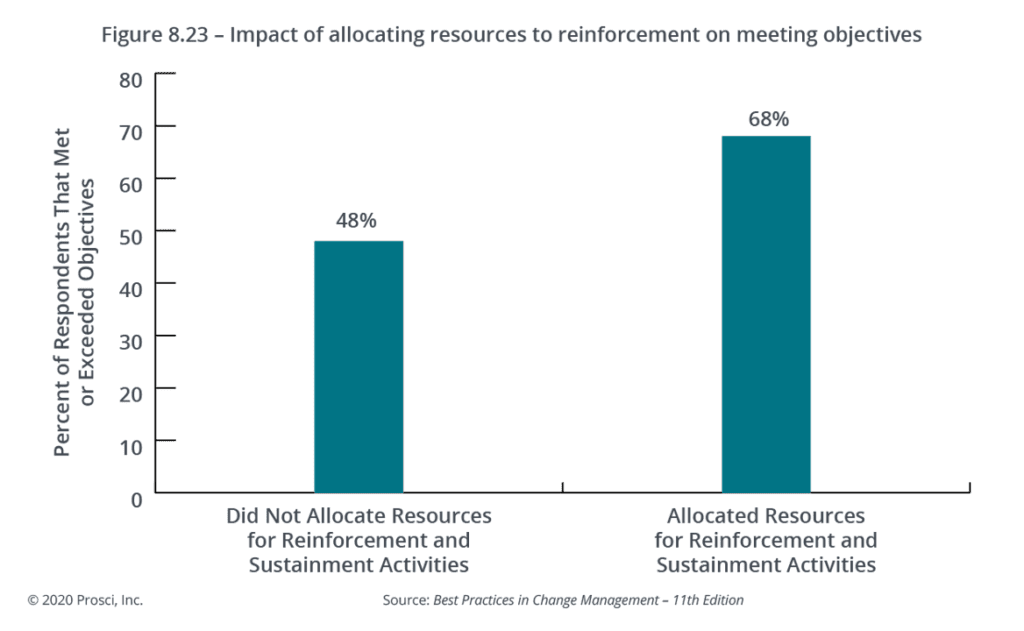
5. Dedicate Change Management Resources
Your project needs dedicated resources and funding to get change management work done. Dedicated change management resources and funding means having access to:
- Appropriate funding and resources
- Dedicated resources with change management experience
- A change team or community of flexible, ambitious, decisive, collaborative individuals
A research participant provided this insightful comment: “If it isn’t someone’s job, then it’s no one’s job.” To realise the benefits of change management, someone must be responsible for it and have access to an appropriate amount of funding. The data reveals a positive and meaningful correlation between having a dedicated resource (person) and overall change management effectiveness. Participants who had dedicated resources were significantly more likely to achieve good or excellent change management effectiveness than those without a dedicated resource.
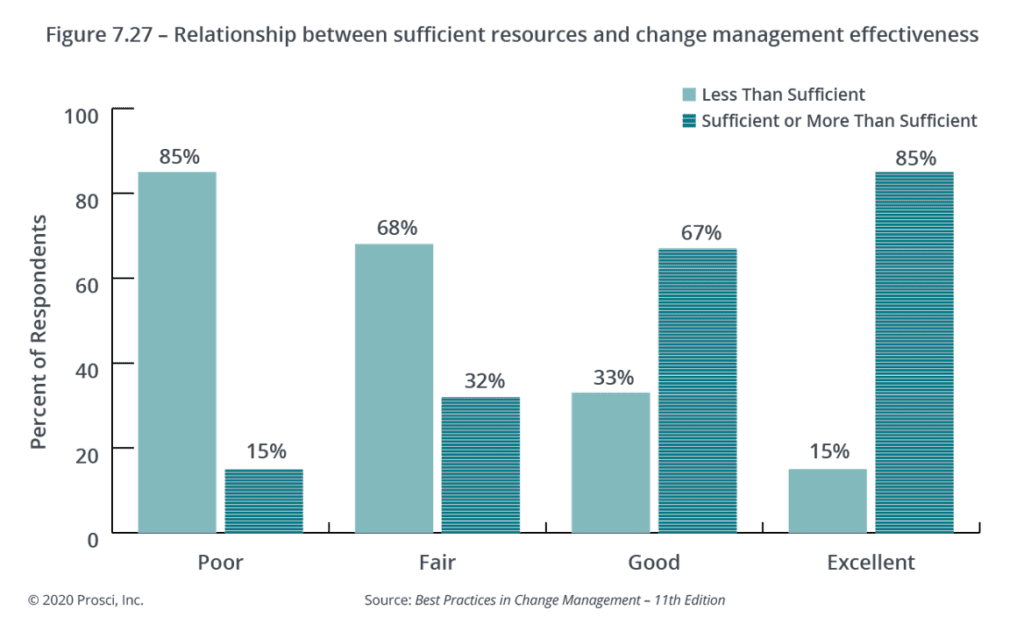
6. Engage and Integrate With Project Management
Prosci’s research has underscored the common trend of integrating change management work with project management activities. These complementary disciplines naturally cross paths throughout the life of an initiative. In the latest study, 74% of participants integrated project management work and change management work to some degree. When they identified this as a top contributor to success, they gave examples of how they achieved integration:
- Adding change management activities to the project plan
- Working collaboratively with the project team
- Aligning change plans with project plans
- Combining or assigning responsibilities and roles
- Providing change management training to the project team
More and more organisations are realising the value of integrating project management and change management. Participants who integrated these two disciplines were 17% more likely to meet or exceed project objectives than those who did not integrate.
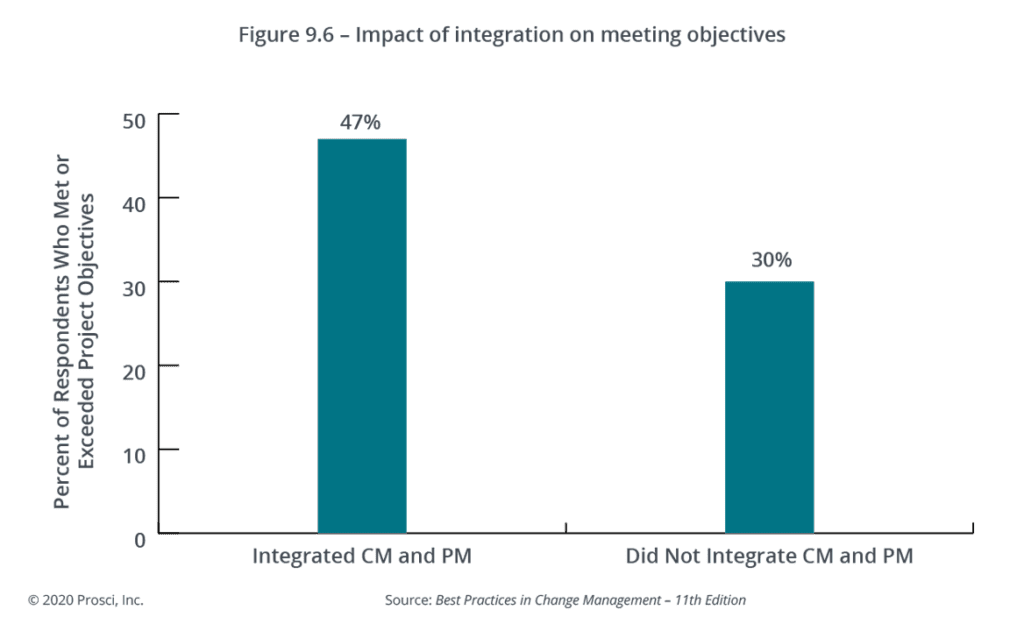
7. Engage With and Support Middle Managers
Managers can become a change practitioner’s greatest ally in times of change because they are closest to employees impacted by change. Participants explained this top contributor as:
- Emphasising communication about the change and the managers’ roles in change
- Holding one-on-one meetings, team meetings and alignment sessions
- Focusing on awareness-building, including how the change will affect them, the business reasons for the change, and the need for change management
- Providing materials, tools and support that will help managers understand and navigate the change
- Engaging and involving managers during the early phases of the change and throughout the project lifecycle
The latest study reveals middle managers as the group most resistant to change, with 42% of participants identifying them as such. Participants believe a majority of this resistance could have been mitigated by thoroughly addressing this group in the change plan.

What This Means for You
Prosci has produced 11 Best Practices in Change Management reports over the last two decades, compiling data from more than 8,000 change leaders in 85 countries. Use these best practices to:
- Start your change management work with the concepts that matter most
- Evaluate your current approach
- Intentionally incorporate best practices into your daily work
The discipline of change management is still growing, and the best practices have grown and changed over the years. By considering and implementing the best practices presented here, you and your organization can continue to grow and learn along with the discipline.
© PROSCI INC. ALL RIGHTS RESERVED

Written By Prosci
Prosci was founded in 1994 by former Bell Labs engineer and program manager Jeff Hiatt. Today, we are a global team of change fanatics and advocates focused on customer success. Prosci is focused exclusively on change management. When you work with Prosci, you work with the most knowledgeable team in the industry, backed by more than 20 years of change management research and best practices. We're also committed to continually searching for ways to better manage the people side of change in a structured, repeatable way.
